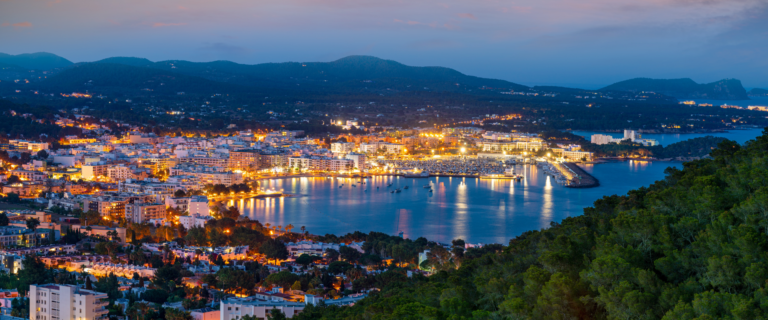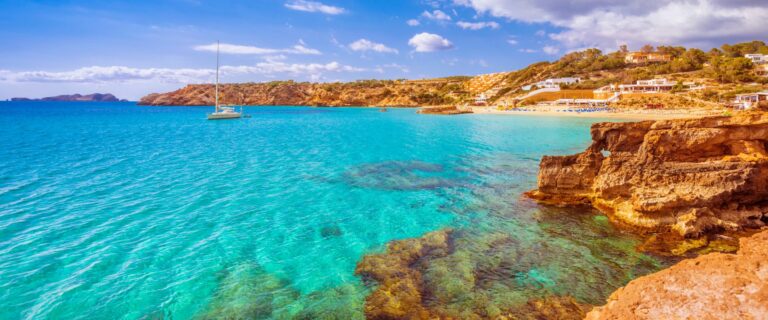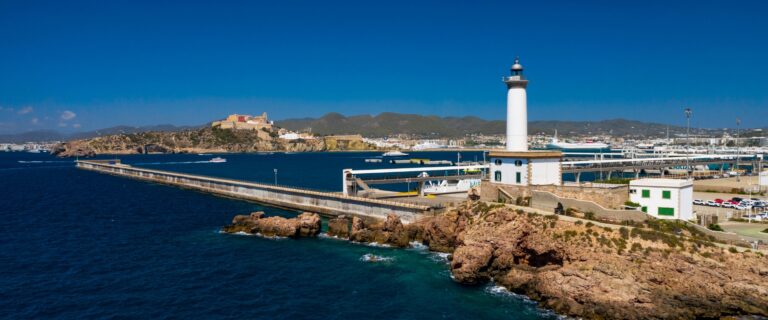Historical Route through Ibiza
Historical Tour of Ibiza
Ibiza is one of the most renowned destinations worldwide, not only for its entertainment offerings, but also for being a prime example of nature, with kilometers of ancient Posidonia meadows and its beautiful beaches with crystal-clear waters. Discover with us a historical route through Ibiza.
However, today we are going to embark on a cultural tour, highlighting the best places on the island. Would you like to learn about its history? We invite you to visit the following places.
Dalt Vila

The historic city of Dalt Vila offers a wide range of attractions to visit. Through its streets, we can see how the city tells a story that dates back to 654 B.C, a time when it is believed that the first Phoenician settlements were built on Puig de la Vila.
During this era, it was a trading hub throughout the entire Mediterranean. During the Arab rule, the city was named Madina Yabisa, and its influence can be seen throughout the entire island. In 1235, Jaume I conquered the island and introduced the feudal Christianity of the period. Later, Jaume II established a self-governing system that remained in place until 1717.
Throughout the 15th and 16th centuries, the prosperity of the city attracted pirates, leading to the construction of the large walls that we can still see today.
Phoenician archaeological site of Sa Caleta

The settlement of Sa Caleta today provides one of the most intriguing models regarding the typology of archaic Western Phoenician houses that are known.
This settlement is the best example of how houses were constructed during the Phoenician era.
The Sa Caleta site is a conglomeration of stone structures built to provide shelter for a large number of inhabitants, and their arrangement is quite uneven.
This place was declared a World Heritage Site, as it is considered the historical precursor to the present-day city. Furthermore, thanks to this settlement, the islands of Ibiza and Formentera were visited by the Phoenicians, placing them at the center of trade in the western Mediterranean and introducing their technology.
Without a doubt, one of the best historical routes in Ibiza.
The Punic necropolis of Puig des Molins

Dada la importancia de esta isla, no es de extrañar que la necrópolis más grande del mundo y mejor conservada se encuentre aquí. Puig des Molins houses one of the most important archaeological sites in human history. The city’s cemetery was constructed by the Phoenicians in the late 7th century BC, and thanks to the city’s expansion during Roman times, it grew to reach just a few meters from the city. Today, the site is part of the Archaeological Museum of Ibiza and Formentera.
Es Botafoc Lighthouse

The Es Botafoc Lighthouse is the most emblematic in the city, built in the 19th century, it stands at the end of the Paseo Marítimo, next to the breakwater.
Initially, the lighthouse operated with an oil lamp; however, it was later changed to a paraffin lamp. Finally, in 1918, electricity was introduced, allowing it to emit a white light with occultations every seven seconds, along with a foghorn that is activated on foggy days. The lantern is located at a height of 16 meters, 31 above sea level, and it can be seen from all over the city.
In 2003, after the expansion of the port, the lighthouse became the focal point upon arriving in the city by boat, whether from Palma, Denia, or Barcelona, in addition to cruise ships. All dock at its feet.
Unfortunately, the interior is not open to the public, but there is an exterior passage that allows for a view of the island of Formentera.
The docks of the port.

The Avinguda de les Andanes used to be a beach where the fishermen gathered. The port was built in the 19th century and has been expanded since then up to the present day.
The avenue starts next to the Ibiza Yacht Club, from the sailor statue, to the port wall, passing by the monument to the privateers.
The entire route is dotted with terraces and bars, and during summer nights, it hosts the famous port market.
Mercat Vell

Shaped like a Greek temple, the Mercat Vell stands in front of the Ses Taules gate, the main entrance to the walls, in the heart of the La Marina neighborhood. Currently, this small market houses several stalls with farm products.
The Mercat Vell is surrounded by terraces, shops, and cafes, and there is always a lively atmosphere around it throughout the year.
Pereira Theater

The Pereira Theater was promoted by the enlightened circles of Ibiza, and its construction was completed in 1899. It is the first building that was erected beyond La Marina, the port neighborhood. Over time, it transformed into a cinema, an activity that continued until the late 1980s of the 20th century. Until a few years ago, it housed a café where jazz and Latin music concerts were offered.
This is our recommendation for a historical route through Ibiza. We also invite you to explore all the experiences we offer at Runaway Experiences.










